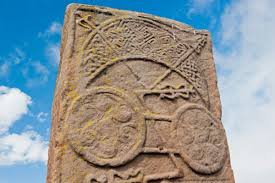It looks like you're using an Ad Blocker.
Please white-list or disable AboveTopSecret.com in your ad-blocking tool.
Thank you.
Some features of ATS will be disabled while you continue to use an ad-blocker.
share:
reply to post by Logarock
Oh yes, the T! Logarock, this is brilliant, thank you so much!!
I may be some time....
Oh yes, the T! Logarock, this is brilliant, thank you so much!!
I may be some time....
beansidhe
reply to post by Logarock
Aah, I see what you mean! On the Dunfallandy stone? Yes, of course, that makes sense. Am I right in thinking then that the crescent V rod and the Z rod are male symbols because they're beside the King? And the Pictish beastie is then female as it's over the queen?
This is exciting, Logarock!
Yes! It is exciting! Yes the dog is like a guardian sprit symbol. Like you see Horus the falcon present in many Egyptian royal works. This Pict stuff is classic old school type royal iconography....which means that these Picts were claiming some decedents from classic royal lines. Just as the Irish kings claimed decent from the Mediterranean families. The fact that the Picts used this iconography means they were, that royal family, was schooled in such.
reply to post by beansidhe
Something else to consider. It was in Egypt that we see the more respect shown female royals in art work. Its even tender and loving at times. Some of the Egyptian King and Queen together art and iconography is among the most recognized ancient art in the world. You just don't see to much of that in the works of the other empires of the area.
Something else to consider. It was in Egypt that we see the more respect shown female royals in art work. Its even tender and loving at times. Some of the Egyptian King and Queen together art and iconography is among the most recognized ancient art in the world. You just don't see to much of that in the works of the other empires of the area.
reply to post by Logarock
I think you are utterly brilliant! We know they had a king's list too, and even though clans existed, there was a very clear leader of them.
I would never have noticed that T sign as significant. i'm going to look into some Egyptian carvings, although I never thought I'd say that at the beginning of this!
Logarock, you rock!
I think you are utterly brilliant! We know they had a king's list too, and even though clans existed, there was a very clear leader of them.
I would never have noticed that T sign as significant. i'm going to look into some Egyptian carvings, although I never thought I'd say that at the beginning of this!
Logarock, you rock!
reply to post by beansidhe
I believe the T is the mystic Tau. Some sources say its the sign of Thoth, though its commonly associated with the sun god(s).
I believe the T is the mystic Tau. Some sources say its the sign of Thoth, though its commonly associated with the sun god(s).
reply to post by Logarock
And what is this just to the upper left of Ramses? That's not a tuning fork, is it? What's going on here? Aargh!
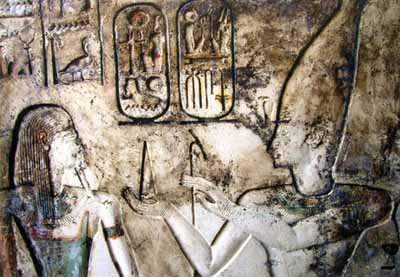
And what is this just to the upper left of Ramses? That's not a tuning fork, is it? What's going on here? Aargh!

reply to post by beansidhe
That tuning fork thing is going to take some digging. On the last stone you posted it looks like a pair of calipers or compass.
That tuning fork thing is going to take some digging. On the last stone you posted it looks like a pair of calipers or compass.
reply to post by Logarock
I think I've found it - it's called a 'mes' in hieroglyphics and it means.. wait for it...son, or born of. Just like 'Mac' in Scotland. Now how's that for a coincidence?!

Here's a better one, on the right:

I think I've found it - it's called a 'mes' in hieroglyphics and it means.. wait for it...son, or born of. Just like 'Mac' in Scotland. Now how's that for a coincidence?!

Here's a better one, on the right:

edit on 10-2-2014 by beansidhe because: Found a better one.
reply to post by beansidhe
That is the stone....
To find it just search Pictish stone astronomical writing
Google produces links to many of the papers
Then do a search on Lascaux astronomical writing, and chauvet cave with the keywords astronomical writing.
going back through the papers you will see how the linear values appear also in early cuneiform text, as well as early chinese text.
That is the stone....
To find it just search Pictish stone astronomical writing
Google produces links to many of the papers
Then do a search on Lascaux astronomical writing, and chauvet cave with the keywords astronomical writing.
going back through the papers you will see how the linear values appear also in early cuneiform text, as well as early chinese text.
reply to post by EnigmaticLInes
Hi there. I'm guessing this is your own research paper? It's extremely interesting.
Is your thinking then that the Picts brought this knowledge with them when they arrived in Scotland, via Orkney and Shetland, and that the Picts were then the indigenous people of Scotland, from the last ice age?
So far we have been considering a number of possibilities, all of which seem to suggest an intelligent and informed group of people who have learned from a 'shared' source.
Hi there. I'm guessing this is your own research paper? It's extremely interesting.
Discussion and Conclusions
The prior study of Ogham and Pictish astronomical writing now strongly suggested that both both writing styles are strongly related, and both originate from an understanding of lunar astronomy. It is clear from this work that the Pictish artwork is much more secretive, with some components only partially drawn. However in the case of Ogham it has to be said there are typically no circular components present on many stones, and thus it is also very difficult directly draw the conclusion that the angular offsets of the written letters are related to lunar astronomical values. Thus the only way that these two samples of astronomical writing could independently be analyzed is by the pre-discovery of even older astronomical proto-writing, as was the approach followed in this study. this permitted the astronomical values to be pre-defined, and to then simply compare the data from more archaic pieces directly to the Ogham and Pictish stones, which are roughly contemporary with one another.
Is your thinking then that the Picts brought this knowledge with them when they arrived in Scotland, via Orkney and Shetland, and that the Picts were then the indigenous people of Scotland, from the last ice age?
So far we have been considering a number of possibilities, all of which seem to suggest an intelligent and informed group of people who have learned from a 'shared' source.
Thinking about the stone above, why does the dolphin/beastie appear beside the woman? And why does it always 'hover', looking down at that strange
angle? And why does it have rolled-up feet - to show it isn't real?
Could it be related to the Goddess Nehalennia?
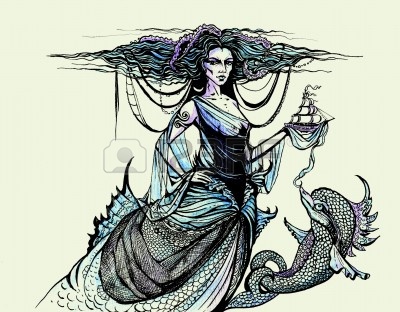
Wikipedia
Other sources I looked at consistently link her with dolphins. So the beastie could maybe represent the protective Goddess?
From a different source:
freya.theladyofthelabyrinth.com...
Could it be related to the Goddess Nehalennia?

Nehalennia (spelled variously) is a goddess. Of unclear origin, perhaps Germanic or Celtic, Nehalennia is attested on and depicted upon numerous votive altars discovered around what is now the province of Zeeland, the Netherlands, where the Rhine River flowed into the North Sea. Worship of Nehalennia dates back at least to the 2nd century BC, and veneration of the goddess flourished in the 2nd and 3rd centuries AD.
Nehalennia is attested on 28 inscriptions discovered in the Dutch town of Domburg on the Zeeland coast, when a storm eroded dunes in 1645, disclosing remains of a temple devoted to the previously unattested goddess Nehalennia.[1] A similar number were discovered in 1971-72 in the town of Colijnsplaat, and two others have been found in the Cologne-Deutz area of what is now Cologne, Germany.[2]
Nehalennia is almost always depicted with marine symbols and a large, benign-looking dog at her feet.
Wikipedia
Other sources I looked at consistently link her with dolphins. So the beastie could maybe represent the protective Goddess?
From a different source:
On thirteen of the twenty-one altars with Nehalennia´s statue on it, the dog sits at her side as her faithful companion. He is a kind of greyhound and has a peaceful appearance. She shares the dog with local deities. It is difficult to decide exactly the significance of Nehalennia´s dog, but the animal´s basic function as a protector and companion is almost certainly established, because of Nehalennia´s function as protector of mariners and travelers. The dog may be connected with the Underworld, as it often is in Greek mythology. It may also be connected to healing, as the dog was a steady companion of the legendary and semi-divine healer Aesculapius, who was brought up by and always accompanied by a dog.[10]
freya.theladyofthelabyrinth.com...
edit on 11-2-2014 by beansidhe because: spacing
edit on 11-2-2014 by beansidhe because: Added source about dog
Logarock
beansidhe
Do you happen to know the exact location where this stone was found?
Hi Logarock
It is Aberlemno III This stone is located in a churchyard. It is not known if it was always there or transported there. Most Pictish stones had to be hidden for a period of time to prevent their destruction.
From Archaeological data it now looks solid that the Picts came from the Sub-sahara. The link between Northern Africa, and Scotland is discussed in the book 400,000 years of Stone Age Science. The book also discusses in far more detail the various world-wide links that are partially introduced in the individual papers.
It also now appears proven - from the latest data coming out of the study of Chauvet, and Lascaux caves, and other similar age artifacts uncovered in Africa, and China - that there was links between these distant locations, and that there was for an extended period a common religion based on a lunar Moon god/goddess being worshipped throughout Europe. This is confirmed by the presence of identical statues that differ in age by circa 25,000 years.
The real discovery being made here is that it can now be confirmed that the Stone Age was really not much different from 15th century Europe. The only real difference I can see was the presence of metal.
reply to post by beansidhe
The Secret is that if you raise to the highest rank of any cult, you learn the "Deity" of that cult is actually just another name for every other "Deity" figure devised.
So look beyond the obvious, look for the hidden.
Dolphin?
This "Sea Pig" must be the secret of Delphi than?
Now we are on to the path!
Ok I'll look into some other aspects and see what I find.
The Secret is that if you raise to the highest rank of any cult, you learn the "Deity" of that cult is actually just another name for every other "Deity" figure devised.
So look beyond the obvious, look for the hidden.
Dolphin?
The name is originally from Greek δελφίς (delphís), "dolphin",[1] which was related to the Greek δελφύς (delphus), "womb".[2] The animal's name can therefore be interpreted as meaning "a 'fish' with a womb".[3] The name was transmitted via the Latin delphinus[4] (the romanization of the later Greek δελφῖνος – delphinos[5]), which in Medieval Latin became dolfinus and in Old French daulphin, which reintroduced the ph into the word. The term mereswine (that is, "sea pig") has also historically been used.[6]
This "Sea Pig" must be the secret of Delphi than?
The name Delphoi comes from the same root as δελφύς delphys, "womb" and may indicate archaic veneration of Gaia at the site.[8][9]
Now we are on to the path!
Apollo is connected with the site by his epithet Δελφίνιος Delphinios, "the Delphinian". The epithet is connected with dolphins (Greek δελφίς,-ῖνος) in the Homeric Hymn to Apollo (line 400), recounting the legend of how Apollo first came to Delphi in the shape of a dolphin, carrying Cretan priests on his back. The Homeric name of the oracle is Pytho (Πυθώ)
Ok I'll look into some other aspects and see what I find.
This is just phase 1 of breaking a few pieces out for you.
I'll mess with it more later.
Neha
Blennioidei
Nehalennia speciosa
This Fly must be the Damsel in Distress? Aka Irene?
Sedge Sprite
Nehalennia (deity)
It notes she is typically seen with a "Dog" which they say is probably a "Greyhound".
Pigs again....
Queen Nehalennia (Sailor Moon)
Nerthus
Njörðr
Njörun
Gefjon
Æsir
Matres
Ok so break the name up more in different ways.
"Hellen"
Tons of other terms under "Halen, Haelen, Hallen," mostly cities though.
'Van Halen', etc, it's everywhere.
So through this 'Hall of Hel' we discover that this deity is pretty well connected with everything.
Love, rain, fertility, death, animals of all sorts, etc.
Obviously that's just a few tidbits but it's a good start on figuring out the figure, imo.
I'll be back later, keep up the good work everyone!
I'll mess with it more later.
Neha
Neha (Hindi: नेहा) is a common Bengali, Indian and Nepali female name originating from the Sanskrit language. Neha means love in Sanskrit, originating from the root word, sneha; but can also be translated to mean rain, originating from the root word, "nehal".
Blennioidei
The common name blenny (deriving from the Greek ἡ βλέννα and τό βλέννος, mucus, slime) is ambiguous at best, as it has been applied to several families of perciform marine, brackish and some freshwater fishes all sharing similar morphology (shape) and behaviour.
Nehalennia speciosa
Nehalennia speciosa (pygmy damselfly, sedgeling or sedgling) is a species of damselfly in family Coenagrionidae.
This Fly must be the Damsel in Distress? Aka Irene?
Sedge Sprite
Nehalennia irene is a species of damselfly in the family Coenagrionidae.
Nehalennia (deity)
Davidson further links the motif of the ship associated with Nehalennia with the Germanic Vanir pair of Freyr and Freyja, as well as the Germanic goddess Nerthus and notes that Nehalennia features some of the same attributes as the Matres.[6]
It notes she is typically seen with a "Dog" which they say is probably a "Greyhound".
According to Pokorny[44] the English name "Greyhound" does not mean "grey dog/hound", but simply "fair dog". Subsequent words have been derived from the Proto-Indo-European root *g'her- "shine, twinkle": English grey, Old High German gris "grey, old", Old Icelandic griss "piglet, pig", Old Icelandic gryja "to dawn", gryjandi "morning twilight", Old Irish grian "sun", Old Church Slavonic zorja "morning twilight, brightness". The common sense of these words is "to shine; bright".
Pigs again....
Queen Nehalennia (Sailor Moon)
Nerthus
Nerthus is often identified with the Vanr Njörðr who is attested in various 13th century Old Norse works and in numerous Scandinavian place names. The connection between the two is due to the linguistic relationship between Njörðr and the reconstructed Proto-Germanic *Nerþuz,[1] Nerthus being the feminine, Latinized form of what Njörðr would have looked like around the first century.[2] This has led to theories about the relation of the two, including that Njörðr may have once been a hermaphroditic deity or that the name may indicate an otherwise unattested divine brother and sister pair such as the Vanir deities Freyja and Freyr.[3] Connections have been proposed between the unnamed mother of Freyja and Freyr and the sister of Njörðr mentioned in Lokasenna and Nerthus.[4]
Njörðr
Additionally, in Old Icelandic translations of Classical mythology the Roman god Saturn's name is glossed as "Njörðr."[4]
Njörun
Gefjon
Æsir
Matres
Ok so break the name up more in different ways.
"Hellen"
Hellen (Ancient Greek: Ἕλλην) was the mythological progenitor of the Hellenes
Tons of other terms under "Halen, Haelen, Hallen," mostly cities though.
'Van Halen', etc, it's everywhere.
So through this 'Hall of Hel' we discover that this deity is pretty well connected with everything.
Love, rain, fertility, death, animals of all sorts, etc.
Obviously that's just a few tidbits but it's a good start on figuring out the figure, imo.
I'll be back later, keep up the good work everyone!
reply to post by beansidhe
Oh yeah, and "Every" deity I have ever come across even the "less significant" ones, are hidden "protector deities".
All of them serve this function in some way or another.
They always guard something, what that is, can vary greatly.
Another addition, the "Dolphin" is in the place of the "Dog" it claims is more usual.
So let's wiki "Sea Dog " and "Sea Dogs".
Term for "Shark", interesting. The "Dolphin" does have scales so I find this interesting to connect.
Pinnipeds
Now check this one out *(click to see photos):
Fog Bow
Sea Dogs (pirates)
Geuzen
So this is just side info to get a better idea of how one can flip it from dog to sea creature so easily.
Oh yeah, and "Every" deity I have ever come across even the "less significant" ones, are hidden "protector deities".
All of them serve this function in some way or another.
They always guard something, what that is, can vary greatly.
Another addition, the "Dolphin" is in the place of the "Dog" it claims is more usual.
So let's wiki "Sea Dog " and "Sea Dogs".
Seadog or sea dog may refer to:
a slang term for a seaman
a slang term for a dog at sea
a slang term for pinnipeds, as in:
a member of the Portland Sea Dogs baseball team
a member of the Saint John Sea Dogs hockey team
Sea Dog Brewing Company, a manufacturer of beer and a chain of restaurants
"Seadog", an episode from the first season of the American television drama series NCIS (see NCIS (season 1))
SEAdog (software), an electronic mail program written by Thom Henderson in the 1980s
a supporter of the defunct Scarborough F.C. or phoenix club Scarborough Athletic F.C.
a mariner's term for a fog bow, an optical phenomenon
an antiquated term for a shark
Term for "Shark", interesting. The "Dolphin" does have scales so I find this interesting to connect.
Pinnipeds
Now check this one out *(click to see photos):
Fog Bow
A fog bow is a similar phenomenon to a rainbow; however, as its name suggests, it appears as a bow in fog rather than rain.
Sea Dogs (pirates)
Geuzen
So this is just side info to get a better idea of how one can flip it from dog to sea creature so easily.
edit on 12-2-2014 by muzzleflash
because: (no reason given)
reply to post by muzzleflash
This is superb, Muzzleflash, thank you so much for all the time you're putting into this. We know pigs had 'celtic' connections as symbols of strength and fertility, so the dog link there is exciting.
Also, you've just reminded me of a previous conversation with Kilgore Trout, when we were talking about Maeshowe in Orkney, a neolithic chambered cairn. It is thought that the ditch around it's base may have been filled with water, which may (or may not!) have been to suggest a return to the womb.
ETA the thread in question
The more I see from your sources, the more I'm wondering about Nehalennia, and her connection with dolphins and the Pictish 'beastie'.
This is superb, Muzzleflash, thank you so much for all the time you're putting into this. We know pigs had 'celtic' connections as symbols of strength and fertility, so the dog link there is exciting.
Also, you've just reminded me of a previous conversation with Kilgore Trout, when we were talking about Maeshowe in Orkney, a neolithic chambered cairn. It is thought that the ditch around it's base may have been filled with water, which may (or may not!) have been to suggest a return to the womb.
ETA the thread in question
The more I see from your sources, the more I'm wondering about Nehalennia, and her connection with dolphins and the Pictish 'beastie'.
edit on
12-2-2014 by beansidhe because: Eta thread link
And again on the Gundestrup cauldron, we see almost identical art to the Pictish stones:
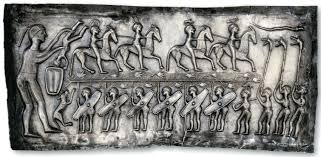
In particular, this plate where there is a possible beastie, with dog's legs (top right):
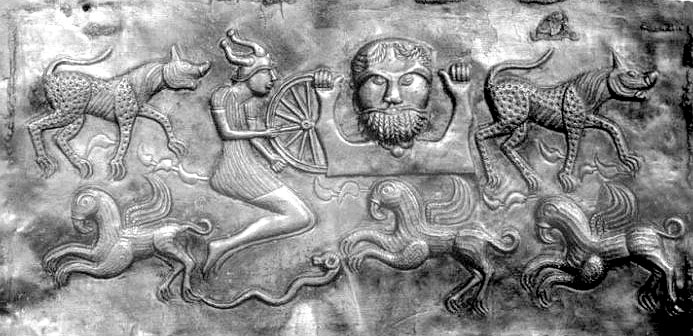
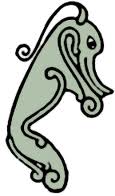
Gundestrup Cauldron

In particular, this plate where there is a possible beastie, with dog's legs (top right):


Gundestrup Cauldron
Nielsen believes that the question of origin is the wrong one to ask and can produce misleading results. Because of the widespread migration of numerous ethnic groups like the Celts and Teutonic peoples and events like Roman expansion and subsequent Romanization, it is highly unlikely that only one ethnic group was responsible for the development of the Gundestrup cauldron. Instead, the make and art of the cauldron can be thought of as the product of a fusion of cultures, each inspiring and expanding upon one another. In the end, Nielsen concludes that, based on accelerator datings from beeswax found on the back of the plates, the vessel was created within the Roman Iron Age at a location somewhere in Central Europe.[1]
edit on 12-2-2014 by beansidhe because: Added quote
reply to post by EnigmaticLInes
Did you know about this recent dig?
Article at BBC
If a culture has 'sophisticated blacksmithing skills' by 490BC, would it be too far a leap to suggest they might have had as of yet undiscovered metal working skills earlier? If we think of the iron age as in fact the steel age, could it leave room to manoeuvre?
The real discovery being made here is that it can now be confirmed that the Stone Age was really not much different from 15th century Europe. The only real difference I can see was the presence of metal.
Did you know about this recent dig?
Archaeologists have identified the earliest use of steel in the British Isles from a site in East Lothian. They now believe artifacts recovered from the site of the Broxmouth Iron Age hill fort were made from high-carbon steel. This would have been deliberately heated and quenched in water, indicating "sophisticated blacksmithing skills". The steel objects were manufactured in the years 490-375BC. Because of their condition, it has not been possible to say definitively if the objects were tools, weapons, or served some other purpose.
Article at BBC
If a culture has 'sophisticated blacksmithing skills' by 490BC, would it be too far a leap to suggest they might have had as of yet undiscovered metal working skills earlier? If we think of the iron age as in fact the steel age, could it leave room to manoeuvre?
new topics
-
Ok this is some BS now WTH
Rant: 4 minutes ago -
France gives Ukraine license to fire long-range missiles at Russia
World War Three: 2 hours ago -
Stalker 2 - Review from a Veteran
Video Games: 5 hours ago -
Does anyone have a link to download apple pay for androids
General Chit Chat: 6 hours ago -
Most INSANE internet rabbit hole
Secret Societies: 6 hours ago -
Joe Rogan conspiracy (maybe)
ATS Skunk Works: 10 hours ago
top topics
-
Results of the use of the Oreshnik missile system in Dnepropetrovsk
World War Three: 12 hours ago, 14 flags -
Most INSANE internet rabbit hole
Secret Societies: 6 hours ago, 8 flags -
Joe Rogan conspiracy (maybe)
ATS Skunk Works: 10 hours ago, 5 flags -
France gives Ukraine license to fire long-range missiles at Russia
World War Three: 2 hours ago, 5 flags -
Nigel Farage now the Most Favoured UK Politician
Regional Politics: 14 hours ago, 4 flags -
Stalker 2 - Review from a Veteran
Video Games: 5 hours ago, 2 flags -
Does anyone have a link to download apple pay for androids
General Chit Chat: 6 hours ago, 1 flags -
Ok this is some BS now WTH
Rant: 4 minutes ago, 0 flags
active topics
-
Ok this is some BS now WTH
Rant • 0 • : VariedcodeSole -
President-Elect TRUMP Picks Former Florida A.G. PAM BONDI to be U.S. Attorney General.
2024 Elections • 63 • : WeMustCare -
France gives Ukraine license to fire long-range missiles at Russia
World War Three • 4 • : nugget1 -
Inca stone masonry at Sacsayhuaman, Ollantaytambo and the Sun Temple
Ancient & Lost Civilizations • 14 • : Astrocometus -
Elon Says It’s ‘Likely’ He Buys Tanking MSNBC
Political Ideology • 77 • : YouSir -
Jaguar Rebrand Video Causes "WTF?" Moment - Seriously Weird
Automotive Discussion • 29 • : AdultMaleHumanUK -
News Aggregators Owned By Liberal Corps Push Out Their Agendas - Even Rumors Are News.
Education and Media • 20 • : WeMustCare -
President-Elect DONALD TRUMP's 2nd-Term Administration Takes Shape.
Political Ideology • 243 • : WeMustCare -
Will Us use alien technology to fight in ww3?
World War Three • 16 • : CosmicFocus -
-@TH3WH17ERABB17- -Q- ---TIME TO SHOW THE WORLD--- -Part- --44--
Dissecting Disinformation • 3362 • : 777Vader

